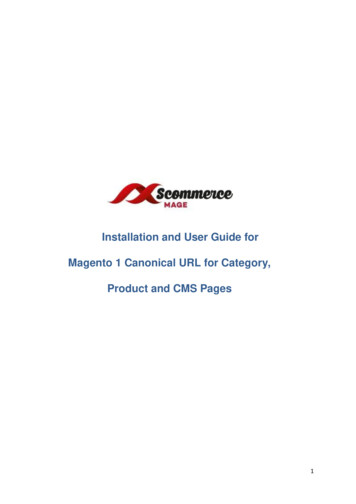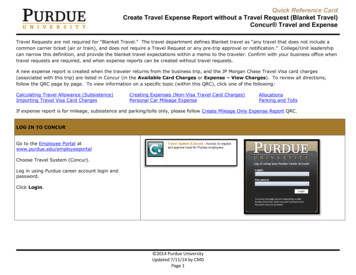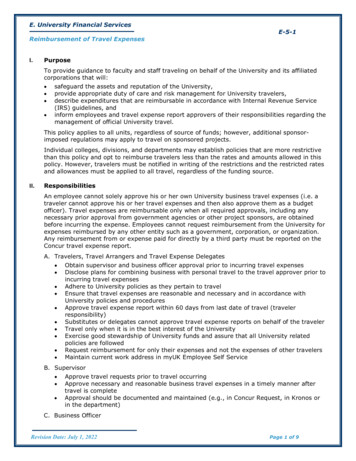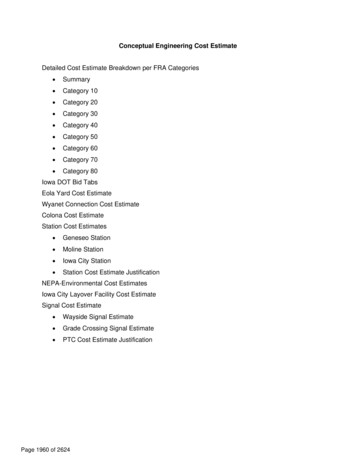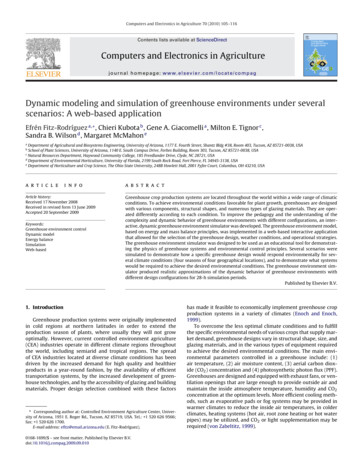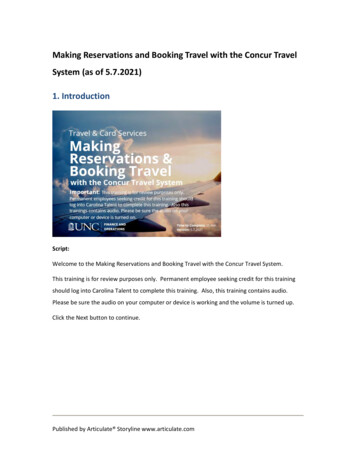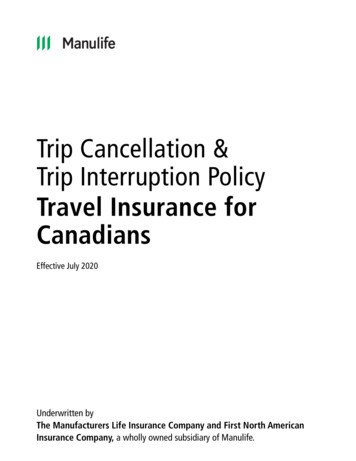
Transcription
6Category 6:Business TravelCategory descriptionThis category includes emissions from the transportation of employees for businessrelated activities in vehicles owned or operated by third parties, such as aircraft,trains, buses, and passenger cars.Emissions from transportation in vehicles owned or controlled by the reporting company are accounted for in eitherscope 1 (for fuel use), or in the case of electric vehicles, scope 2 (for electricity use). Emissions from leased vehiclesoperated by the reporting company not included in scope 1 or scope 2 are accounted for in scope 3, category 8(Upstream leased assets). Emissions from transportation of employees to and from work are accounted for in scope 3,category 7 (Employee commuting). See table 6.1.Emissions from business travel may arise from: Air travelRail travelBus travelAutomobile travel (e.g., business travel in rental cars or employee-owned vehicles other than employee commutingto and from work) Other modes of travel.Companies may optionally include emissions from business travelers staying in hotels.A reporting company’s scope 3 emissions from business travel include the scope 1 and scope 2 emissions oftransportation companies (e.g., airlines).Technical Guidance for Calculating Scope 3 Emissions[81]
CATEGORY 6 Business TravelTable [6.1] Accounting for employee transportation across the value chainActivityRelevant category of emissionsEmissions from transportation in vehicles owned or controlled bythe reporting companyScope 1 (for vehicles that consume fuel) andscope 2 (for vehicles that consume electricity)Emissions from the transportation of employees for business-related activities in vehicles owned or operated by third partiesScope 3, category 6 (Business travel)Emissions from transportation of employees to and from workScope 3, category 7 (Employee commuting)Emissions from leased vehicles operated by the reporting company not included in scope 1 or scope 2Scope 3, category 8 (Upstream leased assets)Calculating emissions from business travelFigure 6.1 gives a decision tree for selecting a calculation method for emissions from business travel. Companies mayuse one of the following methods to calculate scope 3 emissions from business travel: Fuel-based method, which involves determining the amount of fuel consumed during business travel (i.e., scope 1and scope 2 emissions of transport providers) and applying the appropriate emission factor for that fuel Distance-based method, which involves determining the distance and mode of business trips, then applying theappropriate emission factor for the mode used Spend-based method, which involves determining the amount of money spent on each mode of business traveltransport and applying secondary (EEIO) emission factors.Figure [6.1] Decision tree for selecting a calculation method for emissions from business travelDoes business travelcontribute significantly toscope 3 emissions (based onscreening) or is engagementwith travel providersotherwise relevant to thebusiness goals?yesIs data available on thetypes and quantities/costof fuels consumedduring travel?noyesUse thefuel-based methodyesUse thedistance-based methodyesUse thespend-based methodnoIs data available ondistance travelled?noIs data available on theamount of money spenton travel providers?Technical Guidance for Calculating Scope 3 Emissions[82]
CATEGORY 6 Business TravelFuel-based methodThe calculation methodology for the fuel-based method does not differ from the fuel-based method in category 4(Upstream transport and distribution). For guidance on calculating emissions using this method, refer to the guidancefor category 4 (Upstream transport and distribution). Companies may optionally collect data on the number of hotelnights incurred during business travel by hotel type. Under this method, they add the number of hotel nights and theemissions factor of the hotel (as shown in the distance-based method below) to the fuel-based method in category 4(Upstream transport and distribution).Distance-based methodIf data on fuel use is unavailable, companies may use the distance-based method.The distance-based method involves multiplying activity data (i.e., vehicle-kilometers or person-kilometers travelled byvehicle type) by emission factors (typically default national emission factors by vehicle type). Vehicle types include allcategories of aircraft, rail, subway, bus, automobile, etc.Activity data neededCompanies should collect data on: Total distance travelled by each mode of transport (air, train, bus, car, etc.) for employees in the reporting year.Where possible, companies should also collect data on: Countries of travel (since transportation emission factors vary by country) Specific types of vehicles used for travel (since transportation emission factors vary by vehicle types)from transport providers The specific passenger vehicle type and the relevant emission factor.Companies may optionally collect data on the number of hotel nights incurred during business travel by hotel type.Activity data should be expressed as the number of kilometers travelled or kilometers travelled per person for aparticular vehicle type (e.g., passenger-kilometer). The activity data should be summed to obtain total annual kilometersor person-kilometers travelled by each vehicle type used by the company.Emission factors neededCompanies should collect: Emission factors for each mode of transport (e.g., aircraft, rail, metro, bus, taxi, bus), expressed in units ofgreenhouse gas (CO2, CH4, N2O, HFC, or CO2e) emitted per kilometer or per passenger-kilometer travelled.Companies may optionally use emission factors for hotel stays by hotel type (e.g., kilograms of CO2e emitted per hotel night).Note: For air travel emission factors, multipliers or other corrections to account for radiative forcing may be applied tothe GWP of emissions arising from aircraft transport. If applied, companies should disclose the specific factor used.Technical Guidance for Calculating Scope 3 Emissions[83]
CATEGORY 6 Business TravelData collection guidanceMethods of data collection include: Automatic tracking of distance travelled by mode through a travel agency or other travel providers Automatic tracking of distance travelled by mode through internal expense and reimbursement systems,which may require adding new questions on distance travelled and mode of transport to travel or expense formssubmitted by employees Annual surveys/questionnaires of employees Working with travel providers (e.g., transportation companies, hotels) to obtain GHG emissions data.Collecting travel data from all employees may not be feasible. In such a case, companies may extrapolate from arepresentative sample of employees to the total business travel of all employees. For example, a company may have4,000 employees, each of whom has different travel profiles. The company may extrapolate from a representativesample of 400 employees to approximate the total business travel of all employees. Companies may also choose togroup or combine data from business travellers with similar travel profiles. See Appendix A for more information onsampling methods.Calculation resources include: GHG Protocol Calculation Tool, “Mobile Combustion GHG Emissions Calculation Tool. Version 2.0. June 2009,”developed by World Resources Institute, available at ools U.S. EPA Climate Leaders GHG Inventory Protocol, “Optional Emissions from Commuting, Business Travel andProduct Transport,” available at: mmute travel product.pdf For UK organizations, the Department for Transport provides guidance and a calculation tool for work-related travelat: asemissions/.Once the company has determined total annual distance travelled by each mode of transport (aggregated across allemployees), apply the formula below to calculate emissions.Calculation formula [6.1] Distance-based methodCO2e emissions from business travel sum across vehicle types: (distance travelled by vehicle type (vehicle-km or passenger-km) vehicle specific emission factor (kg CO2e/vehicle-km or kg CO2e/passenger-km)) (optional) (annual number of hotel nights (nights) hotel emission factor (kg CO2e/night))Technical Guidance for Calculating Scope 3 Emissions[84]
CATEGORY 6 Business TravelExample [6.1] Calculating emissions from business travel using the distance-based methodCompany A is a financial services company. Every year, it sends groups of professionals to industry conferences in theUnited Kingdom, Australia, and the United States. For each group, the company has collected activity data on the typicaldistances travelled and modes of transport.Data was collected via employee questionnaires and information provided by travel agencies and transportationcompanies. It is assumed that each member of the group travelled the same amount in the same business trip.Road TravelEmployeeGroupNumber ofemployeesin groupCar typeAverageemployeesper vehicleLocationGroup 110Group 2Group 3DistanceEmission factor(km)(kg CO2e/vehicle-km)Hybrid2United States50120Averagegasolinecar2Australia2002100Four wheeldrive3United States1004DistanceEmission factor(km)(kg CO2e/passenger-km)Air TravelEmployeeGroupNumber ofemployeesin groupFlight typeGroup 110Long haul10,0005Group 220Short haul15,0006Group 3100Long haul12,0005Note: the activity data and emission factors in this example are for illustrative purposes only.Technical Guidance for Calculating Scope 3 Emissions[85]
CATEGORY 6 Business TravelExample [6.1] Calculating emissions from business travel using the distance-based method (continued)Three types of flights are identified for calculating emission factors. Short-haul flights have higher emission factors dueto strong influence of the landing/take off cycle on emissions, whereas long-haul flights have slightly higher emissionsthan medium-haul flights due to the additional weight of fuel. Many countries have specific definitions of types offlights. Below is an indicative description: Short haul – flights less than 3 hours in length Medium haul – flights 3-6 hours in length Long haul – journeys made by wide-bodied aircrafts that fly long distance, typically more than 6.5 hours.total business travel emissions of Company A can be calculated as follows:emissions from road travel (distance travelled by vehicle type (vehicle-km or passenger-km) vehicle specific emission factor (kg CO2e/vehicle-km or kg CO2e/passenger-km)) (10/2 50 1) (20/2 200 2) (100/3 100 4) 17,583.33 kg CO2eemissions from air travel (distance travelled by vehicle type (vehicle-km or passenger-km) vehicle specific emission factor (kg CO2e/vehicle-km or kg CO2e/passenger-km)) (10 10,000 5) (20 15,000 6) (100 12,000 5) 8,300,000 kg CO2etotal emissions from employee travel emissions from road travel emissions from air travel 17,583.33 8,300,000 8,317,583.33 kg CO2eSpend-based methodIf it is not possible to use either the fuel- or distance-based methods, companies may use the spend-based method.The calculation method is same as the spend-based method described in Category 4: Upstream Transportationand Distribution, with the difference that the activity data is the amount spent on business travel by type/mode oftransport. Refer to the spend-based method in Category 4 for a description of this method.Companies may optionally collect data on the number of hotel nights incurred during business travel by hotel type.Technical Guidance for Calculating Scope 3 Emissions[86]
car 2 Australia 200 2 Group 3 100 Four wheel drive 3 United States 100 4 Air Travel Employee Group Number of employees in group Flight type Distance Emission factor (km) (kg CO 2 e/passenger-km) Group 1 10 Long haul 10,000 5 Group 2 20 Short haul 15,000 6 Group 3 100 Long haul 12,000 5

